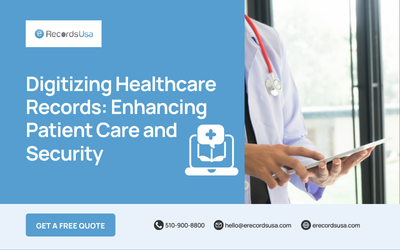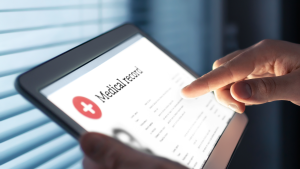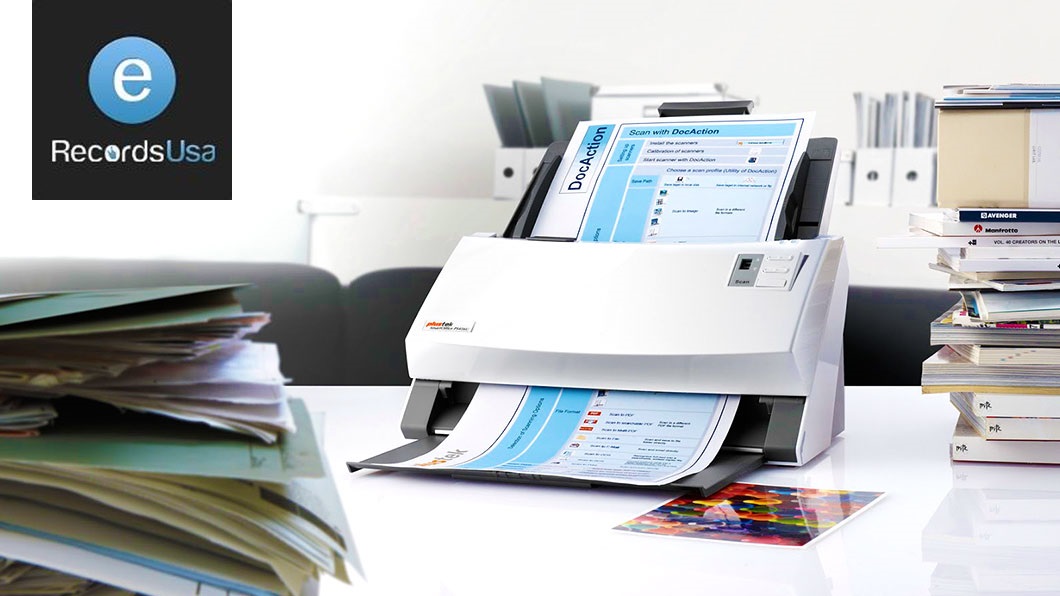[boomdevs_toc]
How Do Electronic Health Records (EHR) Improve Healthcare?
Having trouble keeping up with the paperwork at your healthcare facility? It’s time to discover how digitizing medical records can simplify your operations, freeing you to focus on what truly matters – providing exceptional care to your patients.
As medical record-keeping evolves, precision and efficiency increase. Not too long ago, hospitals had entire rooms filled with patient records. Finding a single file could take hours or even days. But times have changed. According to Globe Newswire, the global healthcare IT market is projected to hit $822.5 billion by 2030. This surge highlights the critical role of digitization in the future of healthcare.
Digitizing medical records isn’t just about converting paper documents to digital. It’s a pledge to patient-centric care. And, digitized records are at the forefront of this transformation.
Today, over 96% of US hospitals use Electronic Health Record (EHR) systems, a massive leap from just 9% in 2008. This trend shows a strong embrace of technology to improve patient outcomes. However, document digitization offers more than convenience and compliance. Through it, decisions can be informed, trends can be predicted, and patient care can be personalized.
In this article, we’ll explore how digitizing medical records can enhance the quality of care in your healthcare facility. Dive in to see how this change can make a real difference for you and your patients.
The Shift Towards Electronic Health Records (EHRs)
Those days when doctors’ offices were stacked high with paper records are gone. Every chart, diagnosis, and treatment plan was a physical document, hard to access and even harder to share. They are becoming a thing of the past.
Recognizing the drawbacks of paper-based systems, the industry began transitioning to Electronic Health Records (EHRs). This shift was driven by the promise of more efficient and error-free healthcare operations. The goal would be to create a unified system in which healthcare providers could instantly access patient information, reducing redundant examinations and minimizing errors.
In 2009, the HITECH Act gave this change a significant push. This law didn’t just encourage the use of EHRs – it provided financial incentives for healthcare providers to adopt and implement these digital systems. Adoption rates increased dramatically as a result.
For patients, EHRs have been nothing short of transformative. No more being tied to a single facility’s paper records. Now, your medical history can move with you, ensuring seamless care coordination wherever you go. Healthcare professionals can access the most current information when making critical decisions, leading to more timely and accurate treatments.
The shift from paper to digital is more than just a tech upgrade. It’s about enhancing patient care and ensuring security. With EHRs, healthcare providers can offer better, faster, and safer care. It’s a win-win for everyone involved.
What Type of Medical Records to Digitize?
Healthcare organizations can digitize a wide range of medical records to enhance patient care and ensure HIPAA compliance. These records can be securely stored in EHR systems or HIPAA-compliant cloud solutions.
An experienced document scanning service provider can digitize the following:
- Referrals: Streamline patient transitions between providers.
- Lab Notebooks & Reports: Provide quick access to lab results.
- Medical History: Maintain comprehensive, portable medical histories.
- Progress Notes: Offer real-time updates on patient conditions.
- Treatment Plans: Ensure continuity and adherence to medical interventions.
- Insurance Papers: Simplify administrative processes.
- Physical Exam Findings: Store complete health assessments.
- Patient Demographic Information: Maintain accurate patient identification and care personalization.
How Digitizing Healthcare Records Enhance Patient Care & Security?
Digitized healthcare records are a pivotal step toward improving patient care and ensuring the security of sensitive information. As healthcare facilities convert from paper-based documents to electronic health records (EHRs), the benefits span across patient outcomes, operational efficiency, and data protection.
Let’s look at the following:
1. Improve Patient Care
The digitization of healthcare records, through Electronic Health Records (EHRs) and Electronic Medical Records (EMRs), has enhanced patient care. It leads to significant improvements in care coordination, accessibility, patient empowerment, and engagement.
- Seamless Care Coordination – EHRs and EMRs enable seamless care coordination. Digitizing patient records allows healthcare providers to easily share and access vital patient information across different facilities. This interconnectedness ensures that every healthcare professional involved in a patient’s care has the most current and comprehensive data, reducing the likelihood of errors and ensuring that treatments are consistent and well-informed. For example, a patient visiting a specialist can be assured that their primary care physician’s notes and past treatments are readily available, facilitating better decision-making and continuity of care.
- Accessibility Across Multiple Facilities – Gone are the days when patient records were confined to the physical premises of a single healthcare facility. With EHRs, medical histories, test results, and treatment plans can travel with the patient, accessible from any location within the healthcare network. This is particularly beneficial for patients who move frequently or require care from multiple specialists. It ensures that their health information is always up-to-date and available, no matter where they seek treatment, leading to more accurate diagnoses and effective care plans.
- Patient Empowerment and Engagement – Digitized healthcare records empower patients by giving them access to their medical information. Many EHR systems include patient portals where individuals can view their health records, track their progress, and communicate with their healthcare providers. This transparency fosters a sense of ownership over their health, encouraging patients to engage more actively in their care. When patients are informed and involved, they are more likely to follow treatment plans and make lifestyle changes that improve their health outcomes.
2. Operational Efficiency in Healthcare
The move to digital records has also greatly enhanced the operational efficiency of healthcare facilities, streamlining administrative processes, optimizing costs, and improving accuracy.
- Streamline Administrative Processes – One of the most immediate benefits of digitizing healthcare records is the streamlining of administrative tasks. EHRs automate many of the manual processes that once consumed significant time and resources, such as filing, retrieving, and updating patient records. This automation frees up healthcare staff to focus more on patient care rather than paperwork. Tasks like scheduling, billing, and reporting become faster and more efficient, reducing wait times and improving overall service delivery.
- Cost Savings and Resource Optimization – While the initial investment in EHR systems can be substantial, the long-term cost savings are significant. Digital records reduce the need for physical storage space, paper, and other supplies. Additionally, the reduction in administrative errors and redundancies leads to fewer costly mistakes. Optimizing resources and streamlining operations can reallocate funds and efforts toward improving patient care and expanding services.
- Reduce Redundancies and Improve Accuracy – EHRs minimize the risk of redundant tests and procedures, which are common in paper-based systems due to fragmented information. With all patient data centralized and easily accessible, healthcare providers can see the complete medical history and avoid unnecessary duplications. This not only saves costs but also spares patients from undergoing repetitive tests and treatments, reducing stress and enhancing their overall healthcare experience.
3. Security and Data Protection
The shift to digital records brings with it enhanced security measures, disaster recovery capabilities, and fraud prevention mechanisms, ensuring that patient data remains protected and secure.
- Enhance Data Security Measures – Digitized records are fortified with advanced security protocols that far surpass the protections of traditional paper records. EHR systems use encryption, secure access controls, and regular security audits to safeguard sensitive patient information. Only authorized personnel can access the data, and all interactions with the records are logged, providing a robust layer of security against unauthorized access and breaches.
- Disaster Recovery and Data Integrity – Paper records are vulnerable to damage from disasters such as fires, floods, and other unforeseen events. In contrast, digital records can be backed up and stored in multiple secure locations, ensuring that they are not lost even if one site is compromised. This redundancy guarantees that patient data remains intact and accessible, allowing healthcare facilities to continue operations with minimal disruption in the event of a disaster.
- Fraud Prevention and Secure Access Controls – Digital records offer a significant advantage in fraud prevention. EHR systems track every access and modification made to patient records, creating an audit trail that can be reviewed to detect and investigate suspicious activities. Secure access controls ensure that only authorized users can view or alter the data, protecting against fraudulent activities and ensuring the integrity of patient information.
4. Simplified Adherence
Digitizing records helps meet HIPAA requirements, enhance accessibility, and reduce costs by implementing necessary administrative, physical, and technical safeguards.
- Ensure HIPAA Compliance – The HIPAA Security Rule requires “appropriate administrative, physical, and technical safeguards to ensure the confidentiality, integrity, and security of electronic protected health information (PHI).”Digitizing medical records simplifies adherence to these regulations by allowing healthcare providers to encrypt sensitive data, maintain audit trails, and securely share patient information. Digital records are also more secure, preventing issues like mislabeling, misplacement, and destruction from disasters such as fires or floods.
- Improve Accessibility – Digitized medical records are easily searchable and accessible to authorized personnel, enhancing communication and collaboration within healthcare organizations. By consolidating data into digital formats, providers can quickly access the latest records while protecting them from unauthorized access. This increased accessibility and streamlined workflow lead to better patient care, as medical staff can focus on improving the patient experience rather than searching through paper records.
- Reduce Costs – Digitizing medical records reduces costs by eliminating the need for physical storage systems like filing cabinets and shelving units. It also cuts printing costs, as records are managed digitally, eliminating the need for hard copies. Additionally, digital record-keeping reduces the time spent on manual tasks related to retrieving and organizing documents, saving labor costs and increasing efficiency.
eRecordsUSA in Digitizing Patient Records!
Digitizing patient records plays a vital role in advancing healthcare and upholding top-notch patient care and data security standards.
eRecordsUSA, a prominent document scanning service provider in the San Francisco Bay Area, CA, is at the forefront of this transformation, offering expert document scanning services that comply with HIPAA regulations. Specializing in Medical Records Scanning, eRecordsUSA digitizes a variety of medical records to help healthcare institutions streamline operations, improve patient care coordination, and ensure robust data security.
By transitioning from paper to digital with eRecordsUSA, healthcare facilities guarantee that patient information remains accessible, accurate, and confidential.
Make the switch to digital patient records with eRecordsUSA. Contact us today to discover the advantages of a more efficient, secure, and patient-focused system.




















